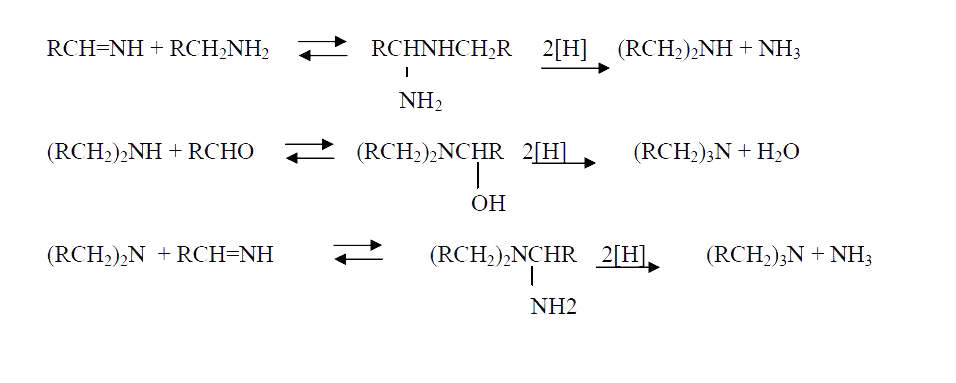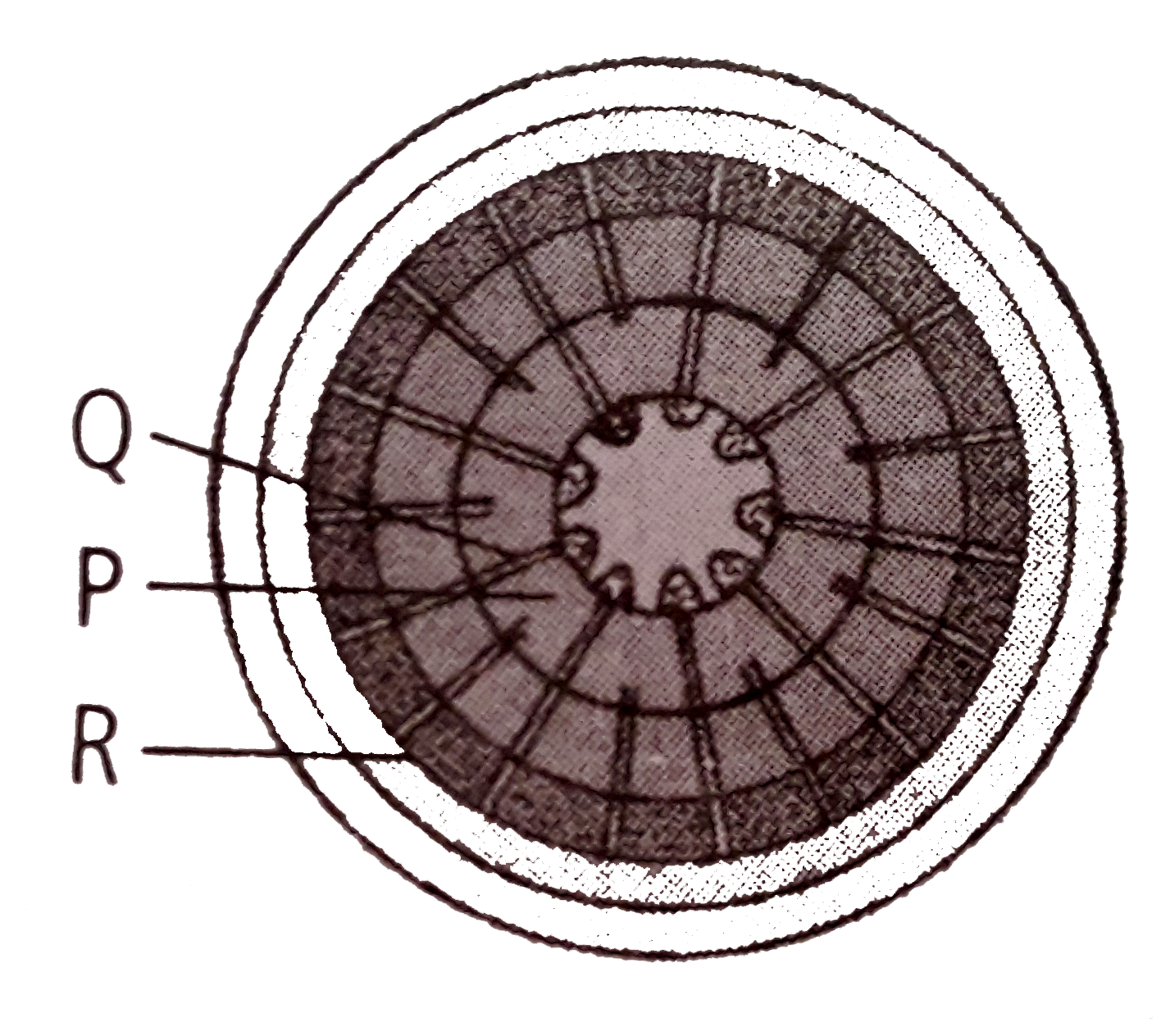During secondarry growth , at same places ,the cambium forms narrow band of parenchyma, which passes through the secondary xylem and the secondary phloem in the radial directions. These are called
Medullary rays
Phelloderm
Secondary medullary rays
Fascicular cambium
The correct Answer is:C
During secondary growth at some places the camsbium forms narrow band of parenchyma, which passses though the secondary xylem and the secondary phloem in the radial irection. These are called secodary medullary rarys
Topper's Solved these Questions
- BOOK - A2ZCHAPTER - ANATOMY OF FLOWERING PLANTSEXERCISE - Section B : Assertion-reasoning Questions12videos
ANATOMY OF FLOWERING PLANTS
- BOOK - A2ZCHAPTER - ANATOMY OF FLOWERING PLANTSEXERCISE - Section C : Previous Years' Examination Question (NEET/AIPMT Questions )71videos
ANATOMY OF FLOWERING PLANTS
- BOOK - A2ZCHAPTER - ANATOMY OF FLOWERING PLANTSEXERCISE - Section A : Topicwise Questions Topic 5: Dorsiventral (dicotyledonous ) And Isobilateral (monocotyle15videos
ANATOMY OF FLOWERING PLANTS
- BOOK - A2ZCHAPTER - ANIMAL KINGDOMEXERCISE - Section D : Chapter End Test50videos
ANIMAL KINGDOM
Similar Questions
At some places, the cambium forms a narrow bands of (A)____ which passes throught he secondary xylem and the secondary phloem in the radial directions. These are the (B)_____
View SolutionAssertion: During secondry growth, the amount of secondary xylem produced is more than secondaryt phloem and soon forms a compact mass.
Reason: The vascular cambium (cambial ring) is generally more active on the inner side than on the outer sideView Solution
Knowledge Check
- Question 1 - Select One
During secondary growth in a dicot root, cork cambium is formed by the activity of
AcortexBhypodermisCpericycleDepidermis. - Question 2 - Select One
During secondary growth the amount of secondary xylem produced is more than the secondary phloem because
Athe cambium is more active on the inner sideBthe cambium is more active on the outer sideCthe cambium is equally active on both sides but the xylem is needed moreDthe cambium has no role to play in this difference - Question 3 - Select One
What happens to primary xylem and primary phloem during secondary growth?
AThey got separated far apartBThey get lostCthey develop pitsDThey developed thickenings
Read the passage given below and answer the following questions:
Reductive alkylation is the term applied to the process of introducing alkyl groups into ammonia or a primary or secondary amine by means of an aldehyde or ketone in the presence of a reducing agent. The present discussion is limited to those reductive alkylations in which the reducing agent is hydrogen and a catalyst or "nascent" hydrogen, usually from a metalacid combination, most of these reductive alkylations have been carried out with hydrogen and a catalyst. The principal variation excluded is that in which the reducing agent is formic acid or one of its derivatives, this modification is known as the Leuckart reaction. The process of reductive alkylation of ammonia consists in the addition of ammonia to a carbonyl compound and reduction of the addition compound or its dehydration product. The reaction usually is carried out in ethanol solution when the reduction is to be effected catalytically

Since the primary amine is formed in the presence of the aldehyde it may react in the same way as ammonia, yielding an addition compound, a Schiff's base (RCH=NCH2R) and finally, a secondary amine. Similarly, the primary amine may react with the imine, forming an addition product which also is reduced to a secondary amine Finally, the secondary amine may react with either the aldehyde or the imine to give products which are reduced to tertiary amines.

Similar reactions may occur when the carbonyl compound employed is a ketone.
(source: Emerson, W. S. (2011). The Preparation of Amines by Reductive Alkylation. Organic Reactions, 174–255. doi:10.1002/0471264180.or004.03 )
Acetaldehyde is reacted with ammonia followed by reduction in presence of hydrogen as a catalyst. The primary amine so formed further reacts with acetaldehyde. The Schiff’s base formed during the reaction is:View SolutionRead the passage given below and answer the following questions:
Reductive alkylation is the term applied to the process of introducing alkyl groups into ammonia or a primary or secondary amine by means of an aldehyde or ketone in the presence of a reducing agent. The present discussion is limited to those reductive alkylations in which the reducing agent is hydrogen and a catalyst or "nascent" hydrogen, usually from a metalacid combination, most of these reductive alkylations have been carried out with hydrogen and a catalyst. The principal variation excluded is that in which the reducing agent is formic acid or one of its derivatives, this modification is known as the Leuckart reaction. The process of reductive alkylation of ammonia consists in the addition of ammonia to a carbonyl compound and reduction of the addition compound or its dehydration product. The reaction usually is carried out in ethanol solution when the reduction is to be effected catalytically

Since the primary amine is formed in the presence of the aldehyde it may react in the same way as ammonia, yielding an addition compound, a Schiff's base (RCH=NCH2R) and finally, a secondary amine. Similarly, the primary amine may react with the imine, forming an addition product which also is reduced to a secondary amine Finally, the secondary amine may react with either the aldehyde or the imine to give products which are reduced to tertiary amines.

Similar reactions may occur when the carbonyl compound employed is a ketone.
(source: Emerson, W. S. (2011). The Preparation of Amines by Reductive Alkylation. Organic Reactions, 174–255. doi:10.1002/0471264180.or004.03 )
The reaction of ammonia and its derivatives with aldehydes is called:View SolutionAssertion: Secondary growth usually occurs in dicotyledonous stems.
Reason: The vascular cambium present between xylem and phloem possesses the ability to form secondary xylem and secondary phloem respectively.View SolutionGo through the following statements.
I. The word meristem is derived from Greek, meristos meaning divided.
II. The stele consists of pericycle, vascular bundle and pith.
III. During secondary growth the amount of secondary xylem produced is more than the secondary phloem becuase the cambium is more active on the inner side.
IV. Palm is a monocot plant so it does not increase in girth.
V. The Book “Anatomy of Seed Plants" by Katherine Esau is referred to as Webster's of plant biology.
How.many of the above statements are correct?View Solution
During the secondary growth in a dicotyledonous stem, the fusiform initials of vascular cambium give rise to which of the given labelled part?View Solution

